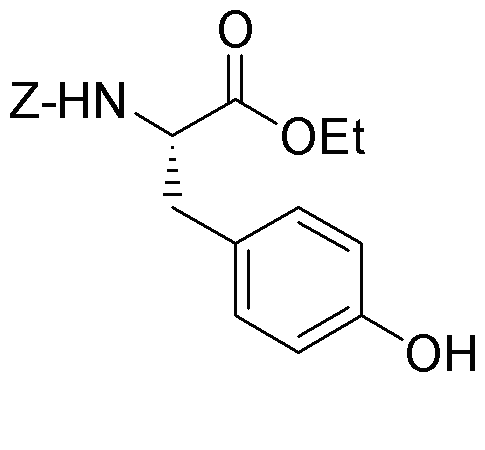Z-L-tyrosine ethyl ester is widely utilized in research focused on:
- Peptide Synthesis: This compound serves as a key building block in the synthesis of peptides, particularly in the pharmaceutical industry, where it can enhance the stability and bioactivity of therapeutic peptides.
- Neurotransmitter Research: It is used in studies related to neurotransmitter function, as tyrosine is a precursor to dopamine, which is crucial for understanding various neurological disorders.
- Cosmetic Formulations: The compound is incorporated into skincare products for its antioxidant properties, helping to protect skin cells from oxidative stress and improve overall skin health.
- Food Industry: As a flavor enhancer, it is added to food products to improve taste and nutritional value, particularly in protein-rich foods.
- Biochemical Assays: Z-L-tyrosine ethyl ester is utilized in various biochemical assays to study enzyme activity and protein interactions, providing valuable insights for researchers in biochemistry and molecular biology.
General Information
Properties
Safety and Regulations
Applications
Z-L-tyrosine ethyl ester is widely utilized in research focused on:
- Peptide Synthesis: This compound serves as a key building block in the synthesis of peptides, particularly in the pharmaceutical industry, where it can enhance the stability and bioactivity of therapeutic peptides.
- Neurotransmitter Research: It is used in studies related to neurotransmitter function, as tyrosine is a precursor to dopamine, which is crucial for understanding various neurological disorders.
- Cosmetic Formulations: The compound is incorporated into skincare products for its antioxidant properties, helping to protect skin cells from oxidative stress and improve overall skin health.
- Food Industry: As a flavor enhancer, it is added to food products to improve taste and nutritional value, particularly in protein-rich foods.
- Biochemical Assays: Z-L-tyrosine ethyl ester is utilized in various biochemical assays to study enzyme activity and protein interactions, providing valuable insights for researchers in biochemistry and molecular biology.
Documents
Safety Data Sheets (SDS)
The SDS provides comprehensive safety information on handling, storage, and disposal of the product.
Product Specification (PS)
The PS provides a comprehensive breakdown of the product’s properties, including chemical composition, physical state, purity, and storage requirements. It also details acceptable quality ranges and the product's intended applications.
Certificates of Analysis (COA)
Search for Certificates of Analysis (COA) by entering the products Lot Number. Lot and Batch Numbers can be found on a product’s label following the words ‘Lot’ or ‘Batch’.
*Catalog Number
*Lot Number
Certificates Of Origin (COO)
This COO confirms the country where the product was manufactured, and also details the materials and components used in it and whether it is derived from natural, synthetic, or other specific sources. This certificate may be required for customs, trade, and regulatory compliance.
*Catalog Number
*Lot Number
Safety Data Sheets (SDS)
The SDS provides comprehensive safety information on handling, storage, and disposal of the product.
DownloadProduct Specification (PS)
The PS provides a comprehensive breakdown of the product’s properties, including chemical composition, physical state, purity, and storage requirements. It also details acceptable quality ranges and the product's intended applications.
DownloadCertificates of Analysis (COA)
Search for Certificates of Analysis (COA) by entering the products Lot Number. Lot and Batch Numbers can be found on a product’s label following the words ‘Lot’ or ‘Batch’.
*Catalog Number
*Lot Number
Certificates Of Origin (COO)
This COO confirms the country where the product was manufactured, and also details the materials and components used in it and whether it is derived from natural, synthetic, or other specific sources. This certificate may be required for customs, trade, and regulatory compliance.


